Page 834 - Fundamentals of Water Treatment Unit Processes : Physical, Chemical, and Biological
P. 834
Appendix C: Miscellaneous Relations 789
Source: Grogan, T., Building Cost Index History, 1923–2010, Engineering
TABLE C.3 News Record, 264(10): 60, March 29, 2010.
Historical ENR 20-City CCI and 20-City BCI a The CCI comprised 200 h of common labor at the 20-city average, plus
25 cwt of standard structural steel shapes, plus 1128 ton of portland cement
Year CCI a BCI b Year CCI a BCI b
at the 20-city price, plus 1088 board-ft of 2 4 lumber at the 20-city price.
1910 1960 824 559 b The CCI comprised 68.38 h of skilled labor (bricklayers, carpenters, and
1911 1961 847 568 structural iron workers) at the 20-city average, plus 25 cwt of standard
1912 1962 872 580 structural steel shapes, plus 1128 ton of portland cement at the 20-city
1913 100 1963 901 594 price, plus 1088 board-ft of 2 4 lumber at the 20-city price.
1914 89 1964 936 612
1915 93 1965 971 627
1916 130 1966 1019 650
components; the CCI incorporates ‘‘common labor’’ and the
1917 181 1967 1074 676
BCI incorporates ‘‘skilled labor.’’ The materials compon-
1918 189 1968 1155 721
ents are the same for each index.
1919 198 159 1969 1269 790
The 20 cities, with respective March 2002 CCI data,
1920 251 207 1970 1381 836
include: Atlanta (2943), Baltimore (3101), Birmingham
1921 202 166 1971 1581 048
1922 174 155 1972 1753 1048 (2825), Boston (4038), Chicago (4256), Cincinnati (6173),
1923 214 186 1973 1895 1138 Cleveland (3624), Dallas (2683), Denver (3029), Detroit
1924 215 186 1974 2020 1205 (4026), Kansas City (6482), Los Angeles (3695), Minneapolis
1925 207 183 1975 2212 1306 (3758), New Orleans (2670), New York (5299), Philadelphia
1926 208 185 1976 2401 1425 (4353), Pittsburgh (3583), St. Louis (3541), San Francisco
1927 206 186 1977 2576 1545 (4031), Seattle (3738). As seen, the CCI vary from a low of
1928 207 188 1978 2776 1674 2671 for New Orleans to a high of 6173 for Cincinnati.
1929 207 191 1979 3003 1819 As stated in Equation C.41, cost may be updated by taking
1930 203 185 1980 3237 1941 the ratio of the CCI for the current year and a given past year
1931 181 168 1981 3535 2097 (or alternatively, the BCI may be used). Such methodology is
1932 157 131 1982 3825 2234 subject to the caveats noted in C.41.
1933 170 148 1983 4066 2384
1934 198 167 1984 4146 2417
ACKNOWLEDGMENT
1935 196 166 1985 4195 2428
1936 206 172 1986 4295 2483 Dr. John Clark, Sear-Brown Consulting Engineers, Fort Col-
1937 235 196 1987 4406 2541
lins, Colorado, provided the discussion of engineering eco-
1938 236 197 1988 4519 2598
nomics and advice on using the ENR index.
1939 236 197 1989 4615 2634
1940 242 203 1980 4732 2702
1941 258 211 1991 4835 2751 REFERENCES
1942 276 222 1992 4985 2834
ENR, First Quarterly Cost Report, ENR, 248(10):64–83, March 18,
1943 290 229 1993 5210 2996
2002.
1944 299 235 1994 5408 3111 ENR, Construction Economics, Cost Indexes, ENR, 250(14):19–20,
1945 308 239 1995 5471 3111 April 14, 2003.
1946 346 262 1996 5620 3203 Griffin, F. L., An Introduction to Mathematical Analysis, revised
1947 413 313 1997 5826 3364 edition, Houghton Mifflin Company, New York, 1936.
1948 461 341 1998 5920 3391 Parkhurst, D. F., Arithmetic versus geometric means for environ-
1949 477 352 1999 6059 3456 mental concentration data, Environmental Science and Tech-
1950 510 375 2000 6221 3539 nology, 32(3):92A–98A, February 1, 1998.
Sowers, G. B. and Sowers, G. F., Introductory Soil Mechanics and
1951 543 401 2001 6334 3574
Foundations, Macmillan, New York, 1951, p. 19.
1952 569 416 2002 6538 3623
1953 600 431 2003 6695 3694
1954 628 446 2004 7115 3984
1955 660 469 2005 7446 4205
1956 692 491 2006 7751 4369
1957 724 509 2007 7967 4486
1958 759 525 2008 8310 4691
1959 797 548 2009 8570 4769

